THE COMPLETE COLLECTION OF UNASYLVA, 1947-2000
Unasylva 1947-2000. CD-ROM. 2000. Rome, FAO. ISBN 92-5-004529-8.
The complete collection of Unasylva from 1947 to 2000 is now available on a single CD-ROM.
Unasylva, FAO's quarterly international journal of forestry and forest industries, provides informative, unbiased analysis on all aspects of forestry including policy and planning, conservation and management of forest-based plants and animals, rural socio-economic development, species improvement, industrial development and international trade. It also considers environmental issues, including the role of forests and trees in maintaining a sustainable base for agricultural production at the micro and macro levels as well as the effects of environmental change on forestry. Unasylva is one of the principal mouthpieces of the Forestry Programme of FAO and reflects its fundamental concern: how to use trees, forests and related resources to improve people's economic, environmental, social and cultural conditions while ensuring that the resource is conserved to meet the needs of future generations.
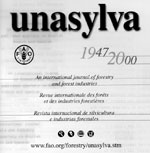
The CD contains the full texts of every issue and all accompanying images, in English, French and Spanish. The collection may be accessed in two ways, by simply browsing through any of the 203 available issues or by using the search engine to identify specific articles by author, title, volume and issue number, publication date and language.
The Unasylva collection is an invaluable, comprehensive resource bringing together 54 years of research, knowledge and analysis into an easily navigable product. As a whole, it presents not only the evolution of FAO's Forestry Programme but also the evolution of international forestry practices, principles and issues.
Criteria and indicators for dry forests in Asia
Development of national-level criteria and indicators for the sustainable management of dry forests in asia: workshop report. 2000. RAP Publication No. 2000/07. Bangkok, Thailand, FAO Regional Office for Asia and the Pacific. ISBN 974-7946-04-1.
Development of national-level criteria and indicators for the sustainable management of dry forests in Asia: background papers. T.L. Cheng and P.B. Durst, eds. 2000. RAP Publication No. 2000/08. Bangkok, Thailand, FAO Regional Office for Asia and the Pacific. ISBN 974-7946-06-8.
Measuring success in the quest for sustainable forest management is a critical issue. Criteria and indicators are tools used to define, assess and monitor sustainable forest management. Criteria encompass socio-economic, environmental, cultural and spiritual dimensions, as well as the productive, protective and social roles of forests. Indicators are measured and monitored to determine the temporal effects of management interventions, in relation to progress towards sustainability, as defined by each criterion.
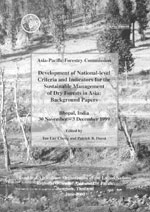
These publications share the background documents and conclusions of a workshop held in Bhopal, India from 30 November to 3 December 1999 on the development of national-level criteria and indicators for the sustainable management of dry Asian forests. The workshop was held at the recommendation of the Asia-Pacific Forestry Commission (APFC) to advance the use of these internationally recognized tools for dry forests in Asia, which have received considerably less research attention than temperate, boreal and tropical moist forests.

The workshop report summarizes the workshop sessions and reviews existing criteria and indicators for dry regions in Asia and other regions. It also reviews the exchange of information and experience in their application. The results are organized into three sections: review of country initiatives and activities in the development and implementation of criteria and indicators; a resulting "reference set" of eight national-level criteria and 49 indicators; and a follow-up plan of action for further development and implementation. Finally, the report summarizes the conclusions and recommendations of the delegates, including the recommendation for incorporation of criteria and indicators into national forestry planning and projects. The need for more research, testing and regional-level training on this topic was noted. Other recommendations included the incorporation of these tools into forestry curricula; the exchange of information, methodologies and experiences; and the further refinement of the reference set of criteria and indicators to accommodate differences in ecological, economic and socio-cultural conditions.
The background papers provide interesting qualitative and quantitative information related to the topic of the workshop. The first article clearly defines the concept and potential value of criteria and indicators as sustainable management tools and also discusses FAO's objectives in their implementation. Successive papers provide examples of the activities and experiences of countries and of other organizations, such as the International Tropical Timber Organization (ITTO) and the Indian Institute of Forest Management (IIFM), in the development and application of such tools. A final summary of these experiences allows for easy identification of the successes and/or weaknesses of particular criteria and indicators.
An anthology of modern forest science
The forests handbook. J. Evans, ed. 2001. Oxford, United Kingdom, Blackwell Science Ltd. Vol. 1, ISBN 0-632-04821-2; Vol. 2, ISBN 0-632-04823-9.
A vital source of building materials, food, fuelwood, medicine and other products, the world's forests are under considerable pressure from the fast-growing global population. Climate change, deforestation, forest fires, insect pests and diseases are also having an impact on these resources. Because of these cumulative factors, the future of the world's forests is uncertain and their conservation has increasingly been given high priority in international arenas. Effective and sustainable forest management must be based on a solid background of science and consideration of other influences such as history, economics and politics. The forests handbook is a comprehensive collection of modern forest science presented in two extensive and informative volumes. It offers a series of overviews on various interrelated topics written by 45 authors from a variety of backgrounds including forestry, biology, ecology, science, academia and management.
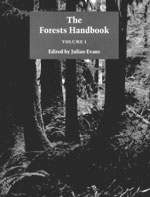
In the opening chapter of Volume 1, J.B. Ball, Head of FAO's Forest Programmes Coordination and Information Unit, discusses the history and dynamics of global forest resources with the support of data from FAO's extensive database of forest statistics. Complementing this historical and statistical information, the second chapter presents a comprehensive overview of the major types of forest and woodland found worldwide. Subsequent sections discuss the intricate and complex biological and ecological processes within forests, environmental interactions and the interactions between forests and humankind.
Volume 2 begins with a review of the history and impact of forest management by S. Rietbergen of the World Conservation Union (IUCN). The first section discusses the uncertain status of worldwide forest reserves, parks and wilderness areas, the role of forests as protection against natural hazards and methods to enhance biodiversity conservation. Subsequent sections discuss the various approaches to sustainable forest management such as soil-centred approaches, participatory or joint forest management, insect pest and fungal disease management and silviculture. The final section provides six country case studies illustrating various key topics related to achieving sustainable forest management such as the importance of ecologically based management and long-term experimentation and monitoring, the role of silvicultural investigations and trials and the recognition and acceptance of current environmental issues.
Sustainable forestry and the forest industry
The business of sustainable forestry: strategies for an industry in transition. M.B. Jenkins and E.T. Smith. 1999. Washington, DC, Island Press. ISBN 1-55963-713-7.
The rapidly expanding human population and the consequent increased demand for wood along with an uncertain, dwindling wood supply and intense environmental pressures are changing the business practices of the forest products industry. These changes have been occurring in tandem with the development and application of sustainable forestry in forest management circles. Sustainable forestry is an approach to forest utilization and management that aims to use trees, forests and their related resources to improve people's economic, environmental, social and cultural conditions while ensuring that the resource is conserved to meet the needs of future generations.
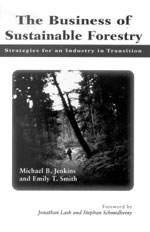
Since the early 1990s, the World Environment and Resources programme at the John D. and Catherine T. MacArthur Foundation has been involved in biodiversity conservation and has been particularly interested in the concept of sustainable forestry. To document successful transitions of the forest products industry towards more sustainable practices, the foundation developed the Sustainable Forestry Working Group in 1996. The group is composed of more than 30 individuals from major environmental groups, universities and industry with experience in resource management, business management, field research and marketing. One of its goals was to develop a series of case studies to illustrate the financial and market opportunities available for, as well as the challenges incurred in, conversion of traditional forest and mill operations to sustainable industries.
This publication presents the results of the Working Group's investigation as an integrated and analytical series of 21 case studies of industry leaders such as Weyerhaeuser Co., the International Paper Co. and Precious Woods, Ltd. The introduction provides a general overview of the evolution of sustainable forest management, while the first chapter discusses the innovations that have been developed throughout this evolutionary process. Subsequent chapters discuss related topics such as certification and privatization, while tying in the experiences of various forest product companies. Overall, the publication provides a comprehensive overview of the business of sustainable forestry, presenting not only the management practices, techniques and technologies but also the lessons learned from early experiences.
Mountain forest conservation and sustainable human development
Forests in sustainable mountain development: a state of knowledge report for 2000. M.F. Price and N. Butt, eds. 2000. IUFRO Research Series No. 5. Oxford, United Kingdom, CABI Publishing. ISBN 0-85199-446-6.
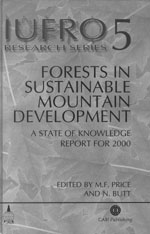
Mountain forests have a recognized role in providing goods and services for the benefit of humankind. Nevertheless, there is a scarcity of empirical data and targeted research demonstrating the links between mountain forest conservation and sustainable human development. In 1996, the International Union of Forestry Research Organizations (IUFRO) established the Task Force on Forests in Sustainable Mountain Development to begin to address this void. The Task Force sought to build on four linked trends: a shift in the emphasis of forestry science and practice from wood production towards a more holistic management perspective; changing expectations of the world's population towards the roles of mountain forests; rapid rates of change in mountain forest cover and utilization; and growing recognition of the global importance of mountain regions and their inhabitants.
Forests in sustainable mountain development is the Task Force's primary output. It covers topics such as the characteristics, trends and location of mountain forests; mountain communities and their forests; interdependencies between mountain and lowland populations; human perceptions of mountain forests; the functions of mountain forests; legislation, policies and economics; mountain forest institutions; and research, implementation and communication. Case studies are provided to help illustrate these topics at the national and local scales.
By providing a diverse and extensive overview of the current themes related to mountain forests, Forests in sustainable mountain development helps to counter the lack of data and research linking conservation of these forests with sustainable human development. It is hoped that such concrete evidence may pave the way for increased action by the global population towards conservation and sustainable management of mountain ecosystems.